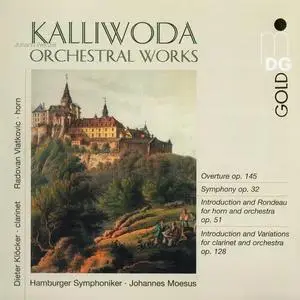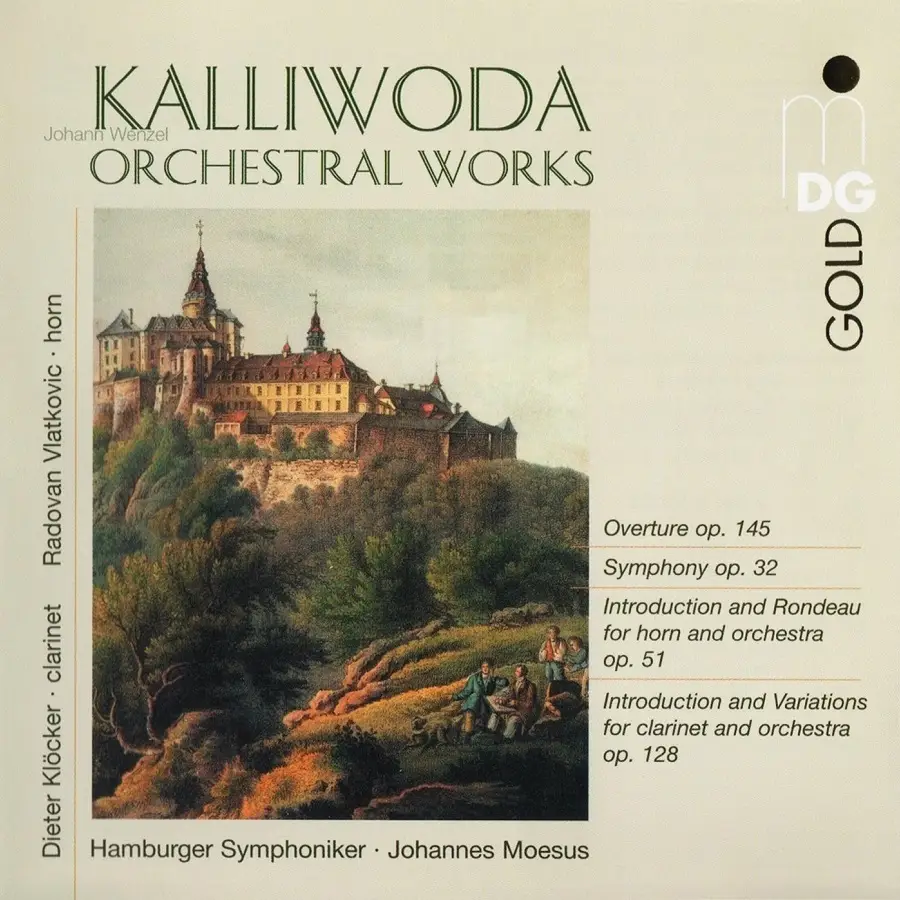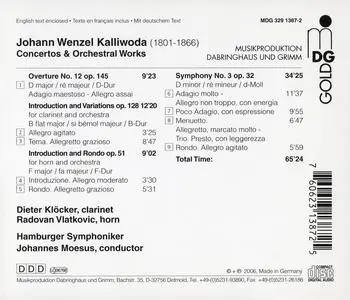Johannes Moesus, Hamburger Symphoniker - Johann Wenzel Kalliwoda: Orchestral Works (2006)
EAC | FLAC | Image (Cue & Log) ~ 275 Mb | Total time: 65:24 | Scans included
Classical | Label: MDG | # 329 1387-2 | Recorded: 2005
EAC | FLAC | Image (Cue & Log) ~ 275 Mb | Total time: 65:24 | Scans included
Classical | Label: MDG | # 329 1387-2 | Recorded: 2005
Leave it to the classical music biz to issue three discs of Kalliwoda orchestral music at exactly the same time! Between Orfeo, CPO, and this newcomer, we now have four of his seven symphonies available in excellent performances (a previous release of Symphonies Nos. 5 and 6 on Centaur isn’t at the same level as these). The four works on the present release give a fine idea of the composer’s wide-ranging inventiveness and ready appeal. The Overture Op. 145 (No. 12 out of a total of 24) was composed around 1843 and has a main theme with almost exactly the same shape as that of the first-movement allegro of Schumann’s Spring Symphony. It’s an ebullient, celebratory work that also contains a popular anthem related to its dedicatee: you can check out the booklet notes if you’re curious.
The Introduction and Variations for clarinet and orchestra is, as you might expect from a Czech composer, brilliantly written and splendidly tuneful. You might say the same about the Introduction and Rondo for horn and orchestra, a delicious confection that gives the soloist a real workout. Both pieces receive sensational performances from clarinetist Dieter Klöcker and horn player Radovan Vlatkovic. It’s such a shame that short concertante pieces like this have all but vanished from the modern repertoire in favor of big, long concertos. Put a few of them together and you’d have a program that would please any self-respecting audience, never mind showing off the talents of the soloist.
The brilliant and original Third Symphony dates from 1830 and was a seminal work in its day. Hearing it now, it’s easy to understand why. Its first movement is built on a five-note motto theme of very odd character (its intervals include a tritone) that Kalliwoda claimed was “discovered” by one of his children who was fiddling at the piano. It gives the music a most interesting harmonic coloration and serves as the basis for some splendid contrapuntal development. There’s a central fugato, in particular, that could have served as the model for any number of subsequent symphonists, especially of the Russian school. This motto returns in both the andante and finale to introduce each movement’s recapitulation, and it turns positively menacing in the symphony’s minor-key coda. Schumann, who knew Kalliwoda’s work well, easily could have been thinking of this piece in structuring his own Second Symphony, and Liszt isn’t too far away either.
Check out the opening wind chords of the andante, followed by solo cello–you might be hearing a foreshadowing of Scheherazade, while the scherzo, here labelled “menuetto”, sounds like a precursor of Dvorák’s Slavonic Dances. The trio section is a light presto that recalls either Mendelssohn or Beethoven, depending on whether you are thinking forward or backward. The finale takes a sidelong glance at the finale of Mozart’s Symphony No. 40 before moving on to its own business. It’s a hugely exciting sonata-rondo movement with another big contrapuntal development section rising to a thrilling climax that’s suddenly cut off so that the motto theme can initiate the recapitulation.
Johannes Moesus leads the Hamburg Symphony in a performance full of character, with excellent wind playing and plenty of presence from the brass and timpani. Not the least of Kalliwoda’s skill lies in his solidly symphonic orchestration, in which everyone has an important part (listen to the wind writing in the andante, for example) and participates equally in the evolving dialog. In this sense Kalliwoda really does differ from most of his contemporaries (above all Schumann, but even Mendelssohn to some extent), with the possible exception of Berlioz. The Third Symphony is an important and masterful piece of music, a landmark in the history of the German romantic symphony. Don’t miss it.–David Hurwitz
Performer:
Dieter Klöcker, clarinet
Radovan Vlatkovic, horn
Hamburger Symphoniker
Johannes Moesus, conductor
Tracklist:
Johann Wenzel Kalliwoda (1801-1866)
01. Overture No. 12 in D major, Op. 145
Introduction, Theme and Variations for clarinet & orchsetra in B flat major, Op. 128
02. I. Allegro agitato
03. II. Tema. Allegretto grazioso
Concert Rondo for horn & orchestra in F major, Op. 51
04. I. Introduzione. Allegro moderato
05. II. Rondo. Allegretto grazioso
Symphony No. 3 in D minor, Op. 32
06. I. Adagio molto - Allegro non troppo, con energia
07. II. Poco Adagio, con espressione
08. III. Menuetto. Allegretto, marcato molto - Trio. Presto, con leggerezza
09. IV. Rondo. Allegro agitato
Exact Audio Copy V1.0 beta 3 from 29. August 2011
EAC extraction logfile from 30. July 2012, 9:14
Johannes Moesus / Kalliwoda - Orchestral Works - Moesus
Used drive : HL-DT-STDVDRAM GSA-H10A Adapter: 0 ID: 0
Read mode : Secure
Utilize accurate stream : Yes
Defeat audio cache : Yes
Make use of C2 pointers : No
Read offset correction : 667
Overread into Lead-In and Lead-Out : No
Fill up missing offset samples with silence : Yes
Delete leading and trailing silent blocks : No
Null samples used in CRC calculations : Yes
Used interface : Native Win32 interface for Win NT & 2000
Used output format : User Defined Encoder
Selected bitrate : 1024 kBit/s
Quality : High
Add ID3 tag : No
Command line compressor : C:\Program Files\Exact Audio Copy\Flac\flac.exe
Additional command line options : -8 -V -T "TITLE=%title%" -T "ARTIST=%artist%" -T "ALBUMARTIST=%albumartist%" -T "ALBUM=%albumtitle%" -T "DATE=%year%" -T "TRACKNUMBER=%tracknr%" -T "TRACKTOTAL=%numtracks%" -T "GENRE=%genre%" -T "COMMENT=%comment%" -T "PERFORMER=%albuminterpret%" -T "COMPOSER=%composer%" %source% -o %dest%
TOC of the extracted CD
Track | Start | Length | Start sector | End sector
––––––––––––––––––––––––––––-
1 | 0:00.00 | 9:30.63 | 0 | 42812
2 | 9:30.63 | 3:25.35 | 42813 | 58222
3 | 12:56.23 | 8:52.53 | 58223 | 98175
4 | 21:49.01 | 3:30.19 | 98176 | 113944
5 | 25:19.20 | 5:37.74 | 113945 | 139293
6 | 30:57.19 | 11:40.46 | 139294 | 191839
7 | 42:37.65 | 9:57.04 | 191840 | 236618
8 | 52:34.69 | 6:47.58 | 236619 | 267201
9 | 59:22.52 | 5:59.30 | 267202 | 294156
Range status and errors
Selected range
Filename F:\Ripped general\[4540] Kalliwoda - Orchestral Works - Moesus\Kalliwoda - Orchestral Works - Moesus.wav
Peak level 86.4 %
Extraction speed 7.3 X
Range quality 100.0 %
Test CRC 1B39B3B4
Copy CRC 1B39B3B4
Copy OK
No errors occurred
AccurateRip summary
Track 1 accurately ripped (confidence 5) [97893B87] (AR v1)
Track 2 accurately ripped (confidence 5) [D5D81D13] (AR v1)
Track 3 accurately ripped (confidence 5) [9A5A75E7] (AR v1)
Track 4 accurately ripped (confidence 5) [F6CC6A85] (AR v1)
Track 5 accurately ripped (confidence 5) [0F9E1ED7] (AR v1)
Track 6 accurately ripped (confidence 5) [A52C6E28] (AR v1)
Track 7 accurately ripped (confidence 5) [7FEDE9FD] (AR v1)
Track 8 accurately ripped (confidence 5) [62F18D41] (AR v1)
Track 9 accurately ripped (confidence 5) [B21CC297] (AR v1)
All tracks accurately ripped
End of status report
Thanks to the original releaser





